Abstract
To reduce the carbon footprint of manufacturing processes, it is necessary to reduce the number of stages in the development process. To this end, integrating additive manufacturing processes with three-dimensional (3D) printing makes it possible to eliminate the need to use tooling for component manufacturing. Furthermore, using 3D printing allows the generation of complex models to optimize different components, reducing the development time and realizing lightweight structures that can be applied in different industries, such as the mobility industry. Printing process parameters have been studied to improve the mechanical properties of printed items. In this regard, although the failure of most structural components occurs under dynamic load, the majority of the evaluations are quasistatic. This work highlights an improvement in fatigue strength under dynamic loads in 3D-printed components through heat treatment. The fatigue resistance was improved regarding the number of cycles and the dispersion of results. This allows 3D-printed polylactic acid components to be structurally used, and increasing their reliability allows their evolution from a prototype to a functional component.
1. Introduction
Three-dimensional (3D) printing is a computer-controlled additive manufacturing process that creates 3D objects by continuous material deposition. The mechanical properties of raw materials evolve into mechanical properties of a 3D-printed component, including the yield strength, ultimate tensile strength, fatigue, ductility, and brittle behavior. Overall, the manufacturing process depends on the component’s geometry, the raw materials, the manufacturing parameters, and the post-treatment processes (e.g., thermal or thermomechanical processes). Traditional processes are usually either subtractive or additive manufacturing processes; however, traditional additive processes, such as foundry or molding, require tooling design, development, and validation. New additive processes in polymer printing, such as fused deposition modelling, eliminate the requirement for additional tooling stages because either only one material is added layer by layer or composite materials are developed in different ways, such as by adding reinforcements to the matrix. To improve the mechanical behavior of 3D-printed components, printing parameters, such as the velocity, bed temperature, extrusion temperature, and raster direction, have been examined because they can generate internal defects that can result in premature failure under quasistatic or dynamic loads [1,2,3]. Travieso-Rodriguez et al. [4] revealed the relationship between printing parameters and quasistatic response in terms of the stiffness and bending strength, but they did not define the parameters necessary to result in an improvement in fatigue strength.
There is still scope to improve 3D printing products, not only by evaluating the printing parameters, but also by adopting post-treatment processes to enhance the mechanical properties of the products [5]. Furthermore, the product’s durability, in terms of fatigue life, should meet the requirements of dynamic loads and statistical parameters, and this should be validated in not just one sample; such validation should be included in lot production to reduce the scattered range found in all components made by considering the same parameters to improve the reliability. By combining printing parameters and optimized designs, the mechanical performance can be improved in a controlled manner [6,7]; however, the deposition process itself generates variability, and hence, there is scope to improve the mechanical performance [8]. The additive metals and plastics are subjected to post-treatment processes, such as thermal treatments, to improve their properties [9,10,11]; one parameter that changes is the hardness of the sample because of microstructural changes. However, the best improvement is observed in homogenization throughout the whole transverse section or as a function of the layer position similar to that observed in dual-phase materials. Homogenization in the microstructure enhances the fatigue strength of the material.
Heat treatments of reinforced plastics or polymer-based compounds show improvements in static and fatigue strengths [9,12]. Different heat treatments may influence the fracture behavior but have minimal effects on tensile strength [13]. The change observed in the mechanical properties depends on the type of heat treatment, as seen in the case of metals. In polymers, thermal treatments can be normalized and annealed [14].
To evaluate this proposal, the effect of heat treatments on hardness was analyzed by performing fatigue tests. The flexibility of additive manufacturing introduces variation among designs, which can generate diverse sets of printing variables. The inherent uncertainty in 3D printing technology, arising from the complicated interaction of heat transformation and dissipation, leads to more pronounced dispersion compared to conventional additive manufacturing methods, such as injection molding, casting, or subtractive processes. Since the material undergoes a phase change during the printing process, a temperature gradient emerges, giving rise to distinct structures across the cross-section. This gradient of hardness and properties contributes to a dispersion in the strength of the 3D-printed component. To achieve greater reliability, we heat-treated 3D samples at different temperatures, and the effects of these treatments were measured via hardness measurements and fatigue tests to evaluate the dynamic behavior of the printed product [15]. Polymeric materials are highly likely to be used in 3D-printed components due to their potential for different applications in various industries, such as mobility (automotive and aircraft), medical, and manufacturing industries. Enhancing their behavior requires normalizing the material in the transverse direction across its thickness. This can be achieved through the application of a thermal treatment. Considering the component as a closed system, the process can be modeled by incorporating the conservation laws of mass, linear momentum, and energy.
where is the density; P is the pressure; is the velocity vector; is the viscous stress tensor; and the specific heat, thermal expansion coefficient, and the heat flux vector are expressed by , , and , respectively.
Although the printing process has similarities to injection processes, one of the biggest differences between the two is that in the printing process, material is deposited directly from the nozzle onto the component. Such deposition affects the temperature gradient. This effect can be evaluated by a shift function () using the polymer parameters and the reference temperature (), expressed by the Williams–Landel–Ferry relation [16] as follows:
In this case, the proposed heat treatment is as follows: perform normalization of each one of the pieces, considering the result reported in previous works that the hardness on the bedside is greater than that on the printing side [17]. The effect of heat treatment has been evaluated by hardness measurements and fatigue life [18]. It is believed that the component’s position in the furnace influences the treatment process, and placing the printing side in contact with the furnace does not cause deformation by heat treatment. Thus, we can define the position in the process so that the side of the printing bed is not in direct contact with the furnace. This study aims to contribute to this growing area of research in the use of polylactic acid (PLA) printed components as structural components. This investigation contributes significantly through a comprehensive approach to printed PLA using FDM. The treatment involves increasing the printing bed temperature by 5 °C. The experimental results showed that the temperature influences the mechanical behaviors of the 3D-printed PLA materials. Hence, it is important to consider multiple printing times because this is the time required for the manufacturing process. The same printing time must be used for the heat treatment to achieve standardization in the component structure. When the oven time equals the printing time, the experimental results’ durability and dispersion are improved.
2. Materials and Methods
We adopted a case study approach to evaluate the mechanical behavior of 3D-printed PLA products. Specimens with a dog-bone geometry and a thickness of 5 mm were printed according to ASTM D7791 [19].
2.1. Additive Manufacturing
Test components were fabricated on a commercial 3D printing machine provided by Ender using a red PLA filament obtained from the brand Color Plus with a diameter of 1.75 mm. The process was carried out at 200 °C in the liquefier chamber and 50 °C in the build platform, with a raster angle of 45°. The manufacturing process of each component took 8 h. A schematic printing process is shown in Figure 1.
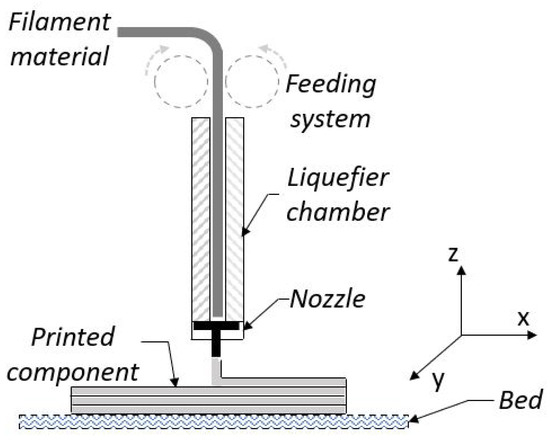
Figure 1.
Schematic 3D printing process.
Printing was performed at a temperature of 205 °C and 50 °C on the printing side and build platform, respectively. Important parameters for components under cyclic loads are the raster angle, set at 45°, and the infill percentage, set to a 100%, as reported in [20]. The specimens were printed at room temperature. Ultimaker Cura was used for slicing the 3D printing model (in STL format). Then, the same software was used to control the settings of the 3D printing process and finally export the G code compatible with the manufacturing machine. Heat treatments were conducted using a precision furnace, preheated for 2 h to stabilize the treatment temperature (Figure 2). The component side that had contact with the printing bed was oriented toward the furnace chamber. An annealing treatment was applied to achieve uniform hardness, improve ductility, and alleviate residual forces generated during printing.
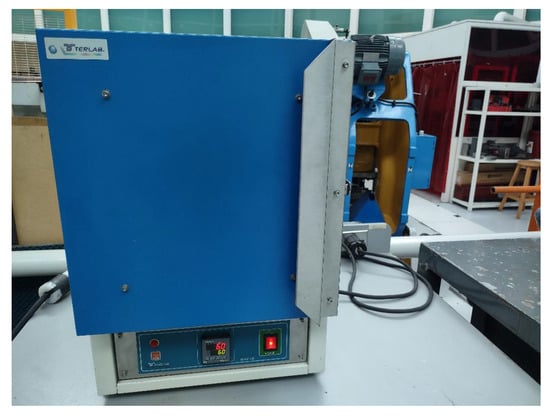
Figure 2.
Heat treat furnace.
Additionally, treatments based on the glass transition temperature were implemented to align the polymer structure. It is important to mention that the heat treatment mechanism can be quenching, normalizing, and annealing. In the quenching process, hardness is heightened; however, the material loses toughness and promptly fractures, leaving minimal time for the material to undergo plastic deformation. In the case of annealing, the specimens tend to develop buckling or warpage, resulting in a complete deformation of the part and the acquisition of both hardness and brittleness, often leading to the loss of the original geometry. The normalizing mechanism effectively controls brittleness and warpage while enhancing the resistance to cyclic loading.
2.2. Mechanical Fatigue
Durability tests were performed on an Instron uniaxial test machine (Figure 3) under the following load conditions at room temperature according to the standard ASTM D7791 [19]: amplitude, 2000 N; frequency, 2 Hz; and R = −1.
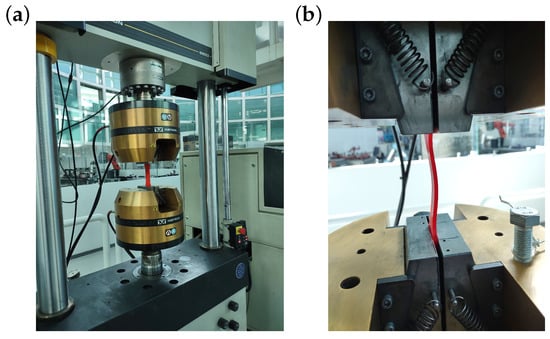
Figure 3.
Uniaxial fatigue test (a) test bench and (b) component at compression load.
The reliability was monitored by obtaining the average number of samples per treatment using the following expression.
where is the result of hardness measurement and cycles, and n is the sample size per variable.
Since each component yields precisely the same results, even under identical manufacturing conditions, assessing the scatter through an analysis of the standard deviation is imperative.
Hardness measurements were taken using an Instron microhardness instrument under a load of 1000 g in 11 a according to ASTM E384 [21]. The first step in this process was to evaluate the printed component without treatment and any support—at least five measurements were taken for each component to evaluate the hardness. The result was defined as the raw component, and the hardness was 18HV. Fatigue assessments were performed until crack propagation. The experimental results were 22,518, 52,307, 35,887, 43,494, and 26,652 cycles. Equations (5) and (6) were employed to analyze the obtained experimental results, which are summarized in Table 1.

Table 1.
Standard deviation in fatigue tests of components without thermal treatment.
This study evaluated the changes in hardness and durability after being subjected to axial fatigue on 46 printed components. Heat treatments play a very important role in the polymer and metal industry. The support effect has a direct relationship with the hardness and fatigue life, and the evaluation of this effect on printed components with thicknesses of 1, 5, 10, 15, and 20 mm is shown schematically in Figure 4. The supports were removed by applying a turn between the component and the bracket section; when the support with a height of 20 mm was separated, a disassembler had to be used to start separating the components.
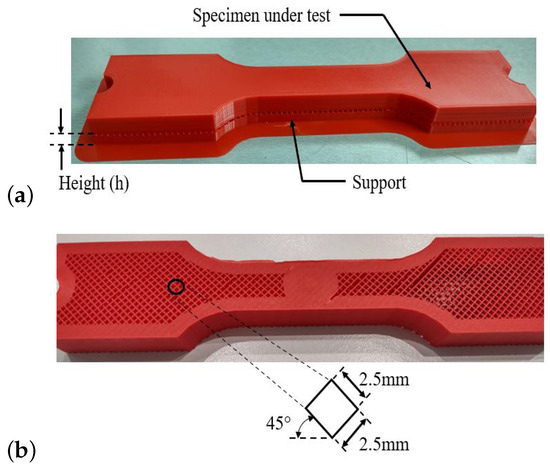
Figure 4.
Component printed with support: (a) as printed and (b) support parameters.
Table 2 summarizes the different heights of the supports and their effects on fatigue strength. The supports have a square geometry of 2.5 mm and they are 0.5 mm thick along the entire component; the difference is the height, which ranges from 1 to 20 mm. A case study approach was used to obtain further in-depth information on the effect of the use of supports on the thermal history of the component. To understand the relationship between the height of the support and the hardness generated in the component, different supports were evaluated to analyze whether they generate a standardized hardness and, at the same time, to understand the mechanical effect of the use of supports on fatigue resistance. In observational studies, there is a potential for bias resulting from different support configurations. Hence, all the supports used in this study had identical parameters to prevent any bias.

Table 2.
Durability strength and hardness measurements of specimens with supports.
As shown in Table 2, the support had an unwanted effect on durability by reducing the mean durability by almost 50%. Notably, the standard deviations are reduced. Although the durability due to the use of supports did not increase, the dispersion of the experimental loads decreased, suggesting that the effect of temperature was reduced. Additionally, there is no difference in hardness for brackets with a size of 10 mm and 20 mm, and the duration of cycles differs only slightly by 0.2%. These results, therefore, need to be interpreted with caution. The obtained hardness was reduced by up to one-third of the component without support and without treatment. A comparison of the supports, hardnesses, and cycle durations does not reveal any direct relationships. The highest value of cycles was obtained with 1 mm-thick supports, yielding a hardness of 14 HV. Although the lowest hardness value coincides with the lowest durability values for the product with brackets, this result was observed only for the 10 and 15 mm brackets.
The effect of the heat treatment is a result of a combination of the effects of the oven temperature, time in the oven, cooling medium, and its velocity [22]. Based on previous research presented by Mayen et al. [23], components with a raster angle of 45° and post-heat treatment of 100 °C show a fatigue life of 18,505 cycles. Bakar et al. [13] evaluated the heat treatment near the glass transition temperature (70–80 °C) of PLA to enhance the durability of the specimen. Another studied temperature range for heat treatment was 80–160 °C for very short periods of time, namely, 60–180 s, and the best improvement was achieved at 120 °C [14].
3. Results and Discussion
For designing a heat treatment method to improve fatigue strength, we considered a combination of temperature, time in the oven, and cooling, as previously described. Cooling was performed at room temperature (23 °C ± 2°). Heat treatment was carried out at 60 °C, 80 °C, and 120 °C for 1 h. Table 3 summarizes the changes in fatigue life after heat treatment at different temperatures.

Table 3.
Experimental results from specimens with heat treatment.
In the 60–120 °C range, the best approach of using 60 °C was evaluated for different oven times. The hardness at this temperature was 20 HV for oven times of 4, 8, 12, and 24 h. Note that there may be possible biases in these responses. Although the hardness was improved at temperatures above 60 °C, this resulted in a brittle component, as seen from the fatigue life evaluation shown in Figure 5.
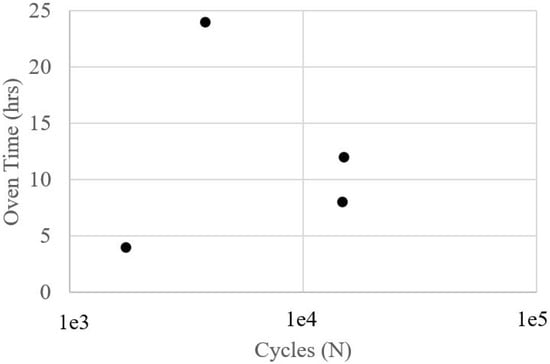
Figure 5.
Semi log test results with a heat treatment of 60 °C.
A comparison of the durability of components with and without treatments showed no enhancement in the behavior above 60 °C. Based on these evaluations, the oven temperature was updated to 55 °C, and the minimum and maximum oven times were 8 h and 168 h, respectively. It is believed that the internal homogenization of the component is not possible within a short time.
Figure 6 shows the duration of each treatment regarding fatigue under the conditions above. The graph shows that the longer the oven time, the higher the durability in some cases. The improvement in resistance to fatigue is noteworthy as it correlates with the duration of oven exposure, attributed to the alignment of polymer chains. This is a consequence of the printed components’ volumetric nature; it is necessary to extend the oven time. Therefore, short treatment durations only alter the edges of the component, leading to brittle failure, even more so than without any treatment.
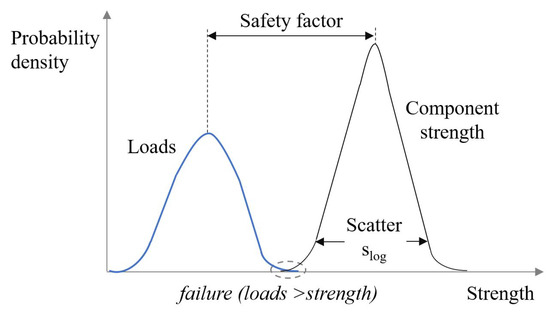
Figure 6.
Failure probability.
Heat treatment enhances the fatigue strength not only in terms of durability but also in terms of scatter reduction. In cases where the results exhibit a positive trend in durability, a minimum of three components with identical characteristics undergo testing. Conversely, two components were tested when the trend indicated a decline in durability, leading to failure. By its inherent nature, the process of accumulated mechanical fatigue damage is a statistical phenomenon dependent on factors such as the design, the load, the material, and the manufacturing process. Design variations can originate from tolerances that allow for a deviation from the nominal value. Loads were then determined by a load spectrum involving all load cases and variables such as the frequency, load sequence, and environmental conditions. Materials can also exhibit variations in mechanical properties, even from the same supplier or within the same production batch. Moreover, manufacturing processes can improve components’ resistance dispersion for subtractive and additive methods. These parameters collectively contribute to an increased strength variation, leading to failure when the most critical load is applied to the component with the lowest strength, as shown in Figure 6.
Hence, decreasing scatter in components exposed to cyclic loads is necessary to mitigate the risk of failure.
The first objective of this study was to improve fatigue strength. For this purpose, the mean value of cycles was evaluated at different oven times with the same printing time (8 h). The mean value of cycles improved 1.25-fold, but importantly, the scatter was reduced by 24.2%, increasing the hardness to 19 HV. The results are summarized in Table 4; the treatment time is described as the oven time.

Table 4.
Experimental results obtained for different oven times at 55 °C.
A temperature of 55 °C (Figure 7) is optimal for the treatments at a time when the material has more life or resistance to fatigue. It is believed that this behavior provides greater durability to the material as it can withstand more load cycles of tension and compression. The material possesses ductility until it ruptures; on the other hand, test components with a shorter duration tend to be brittle.
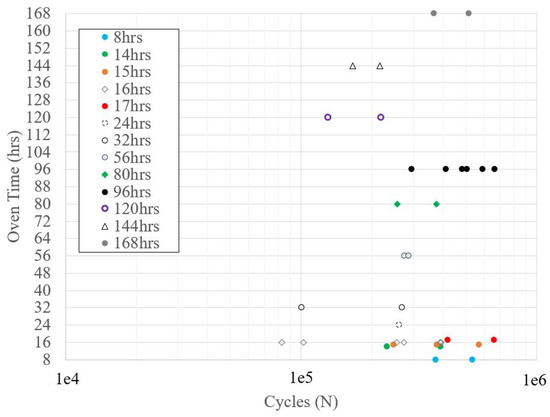
Figure 7.
Semi-log test results with a heat treatment of 55 °C.
During additive manufacturing processes, changes are generated in the properties of the used input material. These changes arise from the state transformation and the layer-by-layer material addition process. This process is based on thermo-mechanical processes and the temperature differences between the printing bed, the printing layer’s temperature, and the molten material being added. Internally, the material develops resistance based on the obtained structural characteristics, while externally, hardness is achieved. For materials produced with these differences, therefore, in this work, the aim is to define an approach that allows the implementation of a thermal treatment standardizing the structure of the component in its cross-section. Initially, the printing time is thought to correlate directly with the overall processing time. The printing time was initially considered to be directly related to the time required for processing. This assumption was based on the results obtained for an oven time of 16 h.
Interestingly, the durability decreased and scatter increased, but importantly, the hardness did not vary. To understand the effect of dispersion, two ranges were defined around this value of 16 h, differing from this value by 1 and 2 h. The same hardness was obtained for an oven time of 14 h, but the component’s durability did not improve without treatment, and a greater dispersion was observed. In 15 h, the fatigue resistance increased 1.30-fold, dispersion decreased by 15.1%, and hardness was reduced to 17 HV. Although at 17 h, the durability was increased 1.49-fold, the dispersion was only reduced by 7.4%; the hardness increased to 19 HV. While analyzing the duration, cycles alone may appear optimal; this approach yields the peak value. However, the integration of dispersion to enhance reliability does not consider of the global dispersion in load, material, design, and manufacturing processes. This could lead to premature failure with increased variability. Ultimately, the hardness was sustained at an oven time of 18 h, but the fatigue resistance decreased and dispersion increased.
These results show similarities with those reported by Shbanah et al. [5], who evaluated the improvement in mechanical properties at 55 °C and 65 °C for 5 h. They reported the best mechanical behavior at 65 °C; however, they adopted a quasistatic evaluation and considered a bed platform temperature of 60 °C. Although the oven time was 5 h, the printing time was 4.5 h. More surprisingly, the oven time was correlated with the printing time. It is possible to define a relationship between the oven time and the same printing time, as shown in this work. Comparing the durability of untreated components with treated components, there is a reduction of 41.5% at 60 °C, 52% at 80 °C, and 78. 6% at 120 °C. The optimum parameters for heat treatment are a temperature of 55° and the same printing time (8 h). This increases the mean duration value at cyclic loads 1.25 times, reducing dispersion by 26.7%
To analyze the effect of the heat treatment on the standardization of the behavior of the component, an optical microscope was used. Three different materials were analyzed: a component without heat treatment, the part with the best durability, and a part with low durability.
Figure 8a shows the specimen without heat treatment. Ductile and brittle behavior can be observed in the same component. On the boundary, it has a lighter color due to ductile behavior. The reddish color in the middle of the cross-section of the component is a result of brittle behavior. Figure 8b shows a specimen after heat treatment for 96 h at 55° with a zoom of 0.8×. Homogenization is shown as whitish bands, resulting in an improved fatigue strength. This component has a fatigue life two times longer than that without treatment. With a treatment of 60 °C for one hour, the structure generates brittleness, as is shown in Figure 8c. The durability diminishes by 92.1%. Figure 8d shows both failure mechanisms; the lower part of the image shows the brittleness and the upper part shows the ductile failure mechanism. In fragile zones, it is observed that failure did not cause any type of deformation, only detachment, i.e., the component separates. In the case of failure due to ductile behavior, plastic deformations and slower crack propagation occur until catastrophic failure occurs.
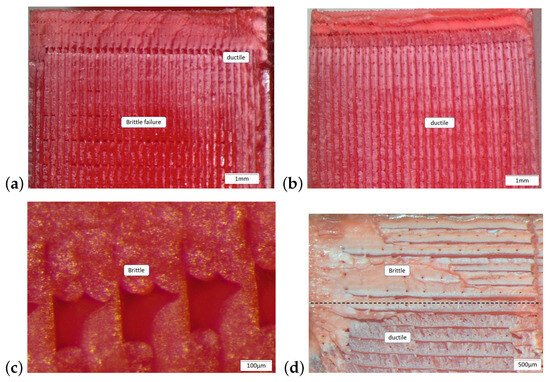
Figure 8.
Optical microscopy of components (a) without treatment, (b) with ductile behavior, and (c) with brittle behavior and (d) a comparison between ductile and brittle failure.
To analyze the behaviour, the component with the worst fatigue strength (Figure 8c) was analyzed via SEM. Figure 9a,b show the ductile behavior on the boundary generated by homogenization. Figure 9c presents the failure in the internal void. This observation may support the hypothesis that the best durability is achieved by homogenizing the component structure along the cross-section.
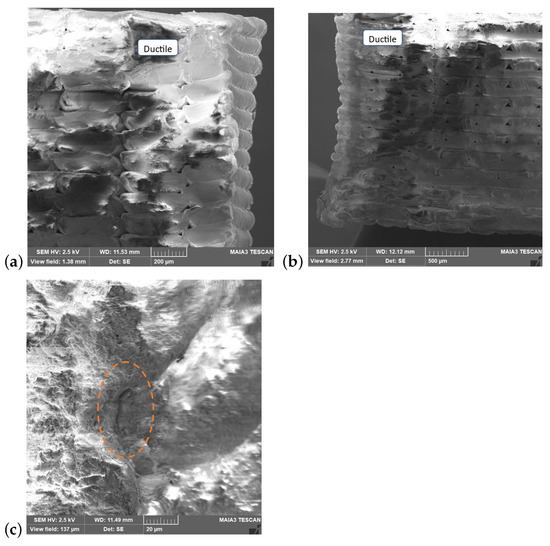
Figure 9.
SEM analysis. (a) Top side of the component, (b) bottom side, and (c) internal failure.
The results of this study show that the fatigue strength of PLA 3D-printed materials can be improved, and the temperature of treatment increases with the temperature of the printing bed at 5 °C. The same printing time must be used to achieve standardization in the component structure. With very short durations, only the edges of the printed component are treated, generating a ductile structure, but within the cross-section, a fragile structure remains. Hence, it is important to state that heat treatments are necessary for additive manufacturing to achieve a homogenized microstructure, reduce scatter, and improve the reliability of the printed components.
The process of accumulated fatigue damage was analyzed by comparing the applied loads with the component strength. This resistance considers the dispersion parameters in design, the material, and the manufacturing processes. The probability of failure is also reduced by reducing the scatter of the component resistance.
Overall, these results indicate that it is possible to evaluate fatigue life strength enhancements as a quantitative value and by using the number of the cycles. Qualitatively, the best improvement was achieved in terms of the scatter. When printing polymers, predicting the dynamic response of fatigue life with a direct parameter such as hardness is impossible.
4. Conclusions
This study aimed to assess the feasibility of post-treatment to improve the dynamic behavior of printed products in the additive manufacturing of polymers. The results support the idea that heat treatment can be applied to 3D-printed PLA components to improve their mechanical performance under dynamic loads. The following conclusions were drawn from this research study:
- The hardness of a component can be improved by thermal treatment. However, obtaining a direct relationship to estimate the fatigue life only from the hardness itself was impossible. Defining the oven time as a function of the printing time is necessary. The best performance was achieved using the same printing time; this generated an improvement not only on the surface but across all the components. A shorter time does not allow for the generation of a homogeneous structure.
- The position of the printed part in the furnace for treatment also affects the mechanical properties of the printed part. This effect originates from the difference in hardness achieved by printing the hardest side (the one that is in contact with the bed) at the exact moment that the printing side is placed in the furnace.
- Normalization is the only treatment that positively affects PLA. The best bed temperature for heat treatment is +5 °C/0 °C.
- The minimum heat treatment time is the printing time. Therefore, short treatment times generate non-homogeneous structures, producing brittle behavior.
Hence, post-processing treatments are necessary in additive manufacturing to achieve a homogenized microstructure, reduce the scatter, and improve the reliability of the printed components.
Author Contributions
Conceptualization, M.J.-M.; methodology, M.J.-M.; validation, J.V.-S. and M.J.-M.; formal analysis, R.C.-E., J.V.-S. and M.J.-M.; investigation, R.C.-E. and M.J.-M.; resources, M.J.-M.; data curation, R.C.-E., J.V.-S., S.G.T.-C., J.C.-P. and M.J.-M.; writing—original draft preparation, J.V.-S. and M.J.-M.; writing—review and editing, M.J.-M.; visualization, R.C.-E., J.V.-S., S.G.T.-C., J.C.-P. and M.J.-M.; supervision, M.J.-M. All authors have read and agreed to the published version of the manuscript.
Funding
This research received no external funding.
Acknowledgments
The authors are grateful for the support of the students of the lightweight structures lab of Tecnologico de Monterrey, and to the department of Mechanics and Advanced Materials for all the support provided for the development of the applied research projects.
Conflicts of Interest
The authors declare no conflicts of interest.
References
- Cox, J.R.; Kipling, I.; Gibbons, G.J. Ensuring supply chain integrity for material extrusion 3D printed polymer parts. Addit. Manuf. 2023, 62, 103403. [Google Scholar] [CrossRef]
- Lampron, O.; Lingua, A.; Therriault, D.; Lévesque, M. Characterization of the non-isotropic tensile and fracture behavior of unidirectional polylactic acid parts manufactured by material extrusion. Addit. Manuf. 2023, 61, 103369. [Google Scholar] [CrossRef]
- Palmieri, M.; Zucca, G.; Morettini, G.; Landi, L.; Cianetti, F. Vibration Fatigue of FDM 3D Printed Structures: The Use of Frequency Domain Approach. Materials 2022, 15, 854. [Google Scholar] [CrossRef] [PubMed]
- Travieso-Rodriguez, J.A.; Jerez-Mesa, R.; Llumà, J.; Traver-Ramos, O.; Gomez-Gras, G.; Roa Rovira, J.J. Mechanical Properties of 3D-Printing Polylactic Acid Parts subjected to Bending Stress and Fatigue Testing. Materials 2019, 12, 3859. [Google Scholar] [CrossRef]
- Shbanah, M.; Jordanov, M.; Nyikes, Z.; Tóth, L.; Kovács, T.A. The Effect of Heat Treatment on a 3D-Printed PLA Polymer’r Mechanical Properties. Polymers 2023, 15, 1587. [Google Scholar] [CrossRef]
- Dizon, J.R.C.; Espera, A.H.; Chen, Q.; Advincula, R.C. Mechanical characterization of 3D-printed polymers. Addit. Manuf. 2018, 20, 44–67. [Google Scholar] [CrossRef]
- Amza, C.G.; Zapciu, A.; Constantin, G.; Baciu, F.; Vasile, M.I. Enhancing Mechanical Properties of Polymer 3D Printed Parts. Polymers 2021, 13, 562. [Google Scholar] [CrossRef]
- Santosh, S.; Nithyanandh, G.; Ashwath, J.; Kishore, K.L. Comparison of internal friction measurements on Ni-Ti reinforced smart composites prepared by additive manufacturing. J. Alloys Compd. 2022, 924, 166027. [Google Scholar] [CrossRef]
- Diniță, A.; Neacșa, A.; Portoacă, A.I.; Tănase, M.; Ilinca, C.N.; Ramadan, I.N. Additive Manufacturing Post-Processing Treatments, a Review with Emphasis on Mechanical Characteristics. Materials 2023, 16, 4610. [Google Scholar] [CrossRef] [PubMed]
- Somireddy, M.; Czekanski, A.; Singh, C.V. Development of constitutive material model of 3D printed structure via FDM. Mater. Today Commun. 2018, 15, 143–152. [Google Scholar] [CrossRef]
- Lim, L.T.; Auras, R.; Rubino, M. Processing technologies for poly(lactic acid). Prog. Polym. Sci. 2008, 33, 820–852. [Google Scholar] [CrossRef]
- Jayanth, N.; Jaswanthraj, K.; Sandeep, S.; Mallaya, N.H.; Siddharth, S.R. Effect of heat treatment on mechanical properties of 3D printed PLA. J. Mech. Behav. Biomed. Mater. 2021, 123, 104764. [Google Scholar] [CrossRef]
- Bakar, A.A.B.A.; Zainuddin, M.Z.B.; Adam, A.N.B.; Noor, I.S.B.M.; Tamchek, N.B.; Alauddin, M.S.B.; Ghazali, M.I.B.M. The study of mechanical properties of poly(lactic) acid PLA-based 3D printed filament under temperature and environmental conditions. Mater. Today Proc. 2022, 67, 652–658. [Google Scholar] [CrossRef]
- Guduru, K.; Srinivasu, G. Effect of post treatment on tensile properties of carbon reinforced PLA composite by 3D printing. Mater. Today Proc. 2020, 33, 5403–5407. [Google Scholar] [CrossRef]
- Vorkapić, M.; Mladenović, I.; Ivanov, T.; Kovačević, A.; Hasan, M.S.; Simonović, A.; Trajković, I. Enhancing mechanical properties of 3D printed thermoplastic polymers by annealing in moulds. Adv. Mech. Eng. 2022, 14, 16878132221120737. [Google Scholar] [CrossRef]
- Yi, S.; Oh, N.; Min, K.E.; Shin, J.S.; Kim, C. Thermo-Viscoelastic Characterization of 3D Printing Polymers. Appl. Sci. 2023, 13, 2876. [Google Scholar] [CrossRef]
- Jimenez-Martinez, M.; Varela-Soriano, J.; Carreón, J.J.R.; Torres-Cedillo, S.G. Mechanical fatigue of PLA in additive manufacturing. Eng. Fail. Anal. 2023, 149, 107273. [Google Scholar] [CrossRef]
- Nazir, A.; Gokcekaya, O.; Md Masum Billah, K.; Ertugrul, O.; Jiang, J.; Sun, J.; Hussain, S. Multi-material additive manufacturing: A systematic review of design, properties, applications, challenges, and 3D printing of materials and cellular metamaterials. Mater. Des. 2023, 226, 111661. [Google Scholar] [CrossRef]
- ASTM. D7791. Uniaxial Fatigue Testing of Plastics. 2012, pp. 1–5. Available online: https://step-lab.com/astm/astm-d7791/ (accessed on 1 October 2023).
- Domingo-Espin, M.; Travieso-Rodriguez, J.A.; Jerez-Mesa, R.; Lluma-Fuentes, J. Fatigue Performance of ABS Specimens Obtained by Fused Filament Fabrication. Materials 2018, 11, 2521. [Google Scholar] [CrossRef]
- E384-17-03-01; Standard Test Method for Microindentation Hardness of Materials. ASTM: West Conshohocken, PA, USA, 2017; pp. 1–40.
- Arash Afshar, D.M. Enhancing durability of 3D printed polymer structures by metallization. J. Mater. Sci. Technol. 2020, 53, 185–191. [Google Scholar] [CrossRef]
- Mayén, J.; Del Carmen Gallegos-Melgar, A.; Pereyra, I.; Poblano-Salas, C.A.; Hernández-Hernández, M.; Betancourt-Cantera, J.; Mercado-Lemus, V.; Del Angel Monroy, M. Descriptive and inferential study of hardness, fatigue life, and crack propagation on PLA 3D-printed parts. Mater. Today Commun. 2022, 32, 103948. [Google Scholar] [CrossRef]
Disclaimer/Publisher’s Note: The statements, opinions and data contained in all publications are solely those of the individual author(s) and contributor(s) and not of MDPI and/or the editor(s). MDPI and/or the editor(s) disclaim responsibility for any injury to people or property resulting from any ideas, methods, instructions or products referred to in the content. |
© 2024 by the authors. Licensee MDPI, Basel, Switzerland. This article is an open access article distributed under the terms and conditions of the Creative Commons Attribution (CC BY) license (https://creativecommons.org/licenses/by/4.0/).